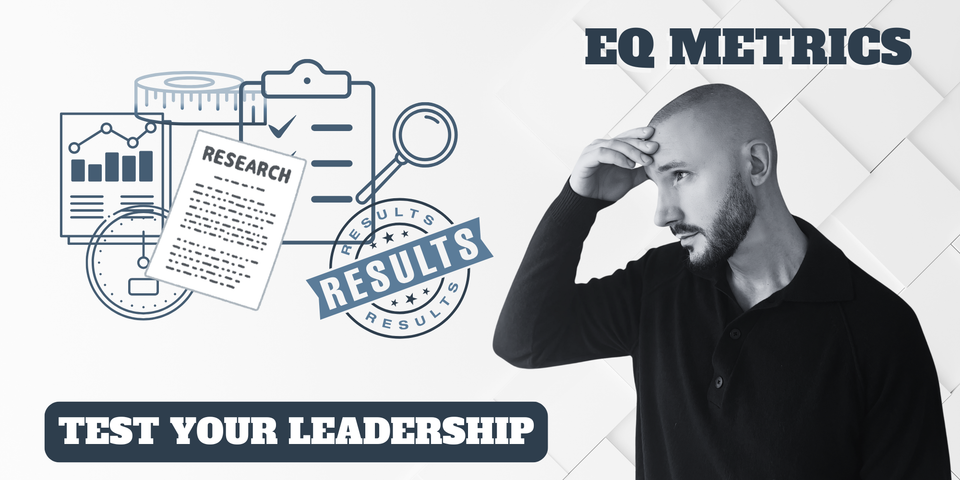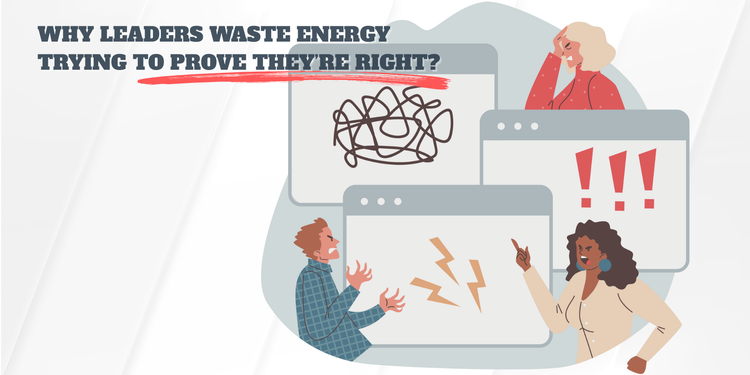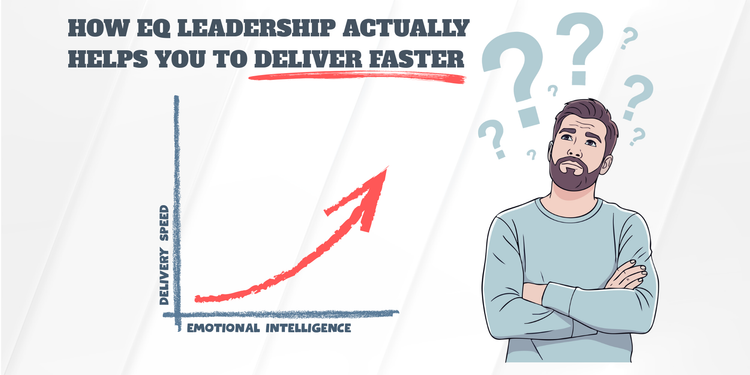EQ Metrics to Test Your Leadership

Leadership often feels impossible to measure.
You can count story points, release velocity, uptime percentages.
But how do you measure trust?
How do you measure whether people feel safe to disagree with you?
How do you know if your presence calms the room - or tightens it?
Most leaders never ask these questions. They focus only on delivery metrics because those are visible and easy to track. But the truth is: the invisible EQ metrics drive the visible results.
When trust is low, deadlines slip quietly.
When people don’t feel heard, engagement fades.
When conflict festers, quality drops.
And when leaders react instead of respond, teams follow suit.
The problem is, without paying attention to EQ signals, you don’t see the issues until they show up in missed goals or burned-out people. By then, the damage is harder to repair.
Emotionally intelligent leaders approach this differently. They know leadership leaves traces, small, measurable signals you can track over time. These aren’t dashboards or vanity numbers. They’re mirrors. They show you not just what you delivered, but how you led.
The question is: are you measuring them?
Why EQ Metrics Matter
Leadership is more than hitting deadlines or clearing backlogs.
It is about the experience people have when working with you.
Do they trust you enough to share the hard truth?
Do they feel safe to raise concerns before it is too late?
Do they leave meetings with more clarity - or more tension?
These questions are not philosophical - they are practical. Because the answers determine whether your team moves fast and with energy, or slow and with quiet resistance.
The challenge is that these answers rarely show up in the metrics most leaders track. Velocity charts, delivery dates, uptime reports - they capture output, not climate. They tell you what was delivered, but not how people felt while delivering it.
And feelings drive performance.
- A team with low trust will miss deadlines no matter how precise your planning is.
- A culture where feedback only flows downward will stagnate no matter how many sprints you complete.
- A group where conflict simmers will eventually produce more rework than results.
That is why EQ metrics matter. They shine a light on the hidden side of leadership - the part that explains why teams either thrive or stall.
Without them, you lead blind. You only find out about issues once they explode into missed goals, disengaged people, or attrition. And by then, the damage is costly and harder to repair.
With them, you get an early warning system. EQ metrics give you signals before problems grow. They tell you when trust is slipping, when silence hides resistance, when your presence raises anxiety instead of lowering it. They are not about perfection - they are about awareness.
Most importantly, EQ metrics keep you honest with yourself. It is easy to believe you are doing well because projects are shipping. But shipping on time is not proof of good leadership - it is proof of short-term delivery. EQ metrics tell you whether people want to keep following you when the deadlines get tough and the pressure rises.
That is the difference. Hard metrics show you what got done. EQ metrics show you how you got there - and whether people will choose to do it with you again.
The Risks of Ignoring EQ Metrics
When leaders track only delivery, they miss the signals that explain why delivery succeeds or fails. Ignoring EQ metrics doesn’t make those signals disappear - it just blinds you to them until the damage is harder to repair.
- Assuming trust exists – Silence in meetings can look like alignment, but often hides resistance. Without measuring trust, you only see it later in slow progress or lack of ownership.
- Believing feedback is flowing – An “open door” is useless if people don’t feel safe to walk through it. Without reciprocity, blind spots grow.
- Mistaking busyness for engagement – Full calendars and long hours can mask burnout. Activity is not the same as motivation.
- Overlooking conflict – Calm meetings may only mean hidden tension. Without tracking how conflict resolves, you risk fractures that weaken the team.
The danger of ignoring EQ metrics is simple: you end up leading blind. Problems stay invisible until they show up as missed goals, disengaged people, or attrition. By then, it’s much harder to recover.
The Psychology of Metrics
Leaders naturally gravitate toward what is easy to measure. Delivery dates, velocity charts, uptime percentages - these are visible, concrete, and objective. They give a sense of control.
EQ, on the other hand, feels subjective. Trust, safety, engagement, conflict - these are harder to quantify. And when something is harder to measure, our brains are quick to dismiss it as “too soft” or “too fuzzy to track.”
There is also ego at play. Delivery metrics can make leaders look successful even when the culture underneath is struggling. EQ metrics, however, hold up a mirror. They can reveal blind spots: that people don’t feel heard, that silence is resistance not agreement, that your presence sometimes raises tension instead of lowering it. Looking into that mirror is uncomfortable, which is why many leaders avoid it.
But discomfort is exactly the point. EQ metrics are not about perfection - they are about awareness. They turn vague impressions into signals you can act on. And once you start paying attention, you notice patterns that were always there but invisible before.
The truth is, what you choose to measure shapes what you choose to improve. If you only measure output, you will only optimize output. If you measure EQ, you begin improving the human side of leadership - the part that ultimately drives everything else.
What EQ Leaders Do Differently
Most leaders measure only what shows up on dashboards. They track deadlines, release cycles, defect counts. These are useful, but they only describe output.
EQ leaders widen the lens. They pay attention to the signals that don’t appear in Jira or project reports. They notice how quickly trust builds when a new teammate joins. They track whether conflicts shorten in their presence or stretch out. They watch how silence feels in meetings - is it agreement, resistance, or withdrawal?
They also check their own balance. Did I listen more than I spoke? Did I invite feedback or just give it? Did my presence calm the room or add pressure?
The difference is subtle but powerful. EQ leaders measure not just what was delivered, but how it was experienced. And that is what separates leadership that gets results for one project - from leadership that sustains results over years.
The 7 EQ Metrics of Leadership
Leadership leaves traces. These seven metrics help you see them clearly:
1. Trust Velocity
- What it is: How quickly people open up and share honestly with you.
- Why it matters: Trust is the foundation of alignment. Without it, you only get surface-level agreement.
- How to spot it: Notice how fast new team members bring up concerns, or how quickly stakeholders confide risks.
2. Listening Ratio
- What it is: The balance of time you spend listening vs. talking in key conversations.
- Why it matters: People feel heard not when you speak clearly, but when you listen deeply.
- How to spot it: After 1:1s or meetings, ask yourself - did I listen more than I spoke?
3. Emotional Climate Stability
- What it is: The steadiness of team mood under pressure.
- Why it matters: High EQ leaders lower volatility. They keep stress from spiraling.
- How to spot it: In tense projects, does the energy remain focused and calm - or swing wildly from anxiety to frustration?
4. Conflict Diffusion Rate
- What it is: How quickly conflicts de-escalate when you step in.
- Why it matters: EQ leaders do not avoid conflict - they resolve it.
- How to spot it: Think back - did your presence shorten disagreements, or make them longer?
5. Feedback Reciprocity
- What it is: The ratio of feedback you receive compared to what you give.
- Why it matters: If feedback only flows one way, people do not feel safe.
- How to spot it: How often do team members proactively give you upward feedback without being asked?
6. Decision Calmness
- What it is: The degree to which your big calls are thoughtful rather than reactive.
- Why it matters: Under pressure, your emotional state sets the tone for the team.
- How to spot it: After high-stakes decisions, reflect - did I pause, consider, and align with values, or did I rush to react?
7. Visibility Without Ego
- What it is: The balance between being recognized for your impact and spotlighting others.
- Why it matters: True leadership is visible without overshadowing the team.
- How to spot it: In cross-team settings, do others acknowledge your leadership naturally - or do you have to push it yourself?
How to Use These Metrics
These seven metrics are not KPIs to add to your dashboard. They are mirrors. They help you see what is usually invisible - the human side of your leadership.
The goal is not to score yourself, but to notice patterns. Over time, these patterns tell you whether your leadership is creating trust, stability, and growth - or eroding them.
Here is how you can start applying them:
- Keep a Leadership EQ Log
After important meetings or tough decisions, jot down quick reflections: Did I listen more than I spoke? Did conflict shorten or lengthen when I stepped in? Did silence feel like agreement, resistance, or withdrawal? - Look for trends, not snapshots
One tense meeting does not define you. But if you consistently notice silence that hides resistance, or feedback that never flows upward, it is a signal to adjust. - Ask the room, not just yourself
Self-reflection is powerful, but not enough. Invite others in. Ask your team: “Do you feel heard?” or “Do you feel safe to raise concerns?” The answers will tell you more than any personal journal. - Check both results and relationships
Measure success by delivery and by experience. If the work ships but people burn out, you have solved a short-term problem by creating a long-term one.
The more you track these EQ metrics, the more natural it becomes. Soon, you will see them without effort - in body language, in silence, in how people respond to your presence. That awareness is what separates reactive managers from leaders who truly elevate their teams.
Practical Tips for Measuring Yourself
EQ metrics are easy to miss unless you build habits to check them. Here are simple ways to start:
- After a 1:1 – Ask yourself: Did I listen more than I spoke?
- After a team meeting – Reflect: Did the silence feel like agreement, resistance, or withdrawal?
- After a conflict – Note: Did my presence calm things down, or escalate tension?
- Each quarter – Ask your team: Do you feel heard, safe, and supported here?
- During high-pressure moments – Pause and check: Am I making this decision calmly, or reacting out of stress?
- When celebrating wins – Look for who you highlight: Am I keeping the spotlight on the team, or pulling it toward myself?
- When a new person joins – Track how quickly they bring up concerns. That tells you how fast trust is forming.
You do not need a dashboard for these. You need reflection, curiosity, and the courage to ask.
Final Word
Most leaders measure output - deadlines, features, results. But those numbers miss the human side of leadership.
EQ metrics fill that gap. They show you if people feel heard, if silence hides resistance, if conflict resolves faster in your presence.
Delivery without EQ is fragile. You might ship today, but lose people tomorrow.
In the end, leadership is not just what got done - it is how people felt while doing it, and whether they would choose to do it with you again.
More Ways I Can Support You?
Work With Me 1:1 – Fast-Track Your Leadership Growth!
If you're serious about accelerating your career and becoming the kind of leader people respect and follow, I offer premium 1:1 coaching tailored to your needs. My coaching focuses on:
👥 Build stronger stakeholder relationships!
🗣️ Increase your confidence and influence!
📊 Have higher retention and engagement!
🕊️ Become a smooth conflict resolver!
🚀 Improve your team’s performance!
🌟 Build your leadership reputation!
🎯 Get promoted a lot faster!
🧘 Avoid burnout and stress!
This isn’t just theory, it’s actionable, personalized coaching based on real-world leadership experience.
Let’s Build Emotionally Intelligent Leaders, Together
I’d love to hear from you:
What’s the biggest leadership challenge you’re facing right now?
Hit reply and let me know. I read every response.
If this resonates with you, share this newsletter with a friend or colleague who could benefit from it.
You can also follow me on LinkedIn for more real-world leadership insights.
Let’s build the future of leadership one insight at a time!
Thanks for reading all the way through!
– Djordje
Founder, The Chronicles of a High-EQ Leader.





Member discussion